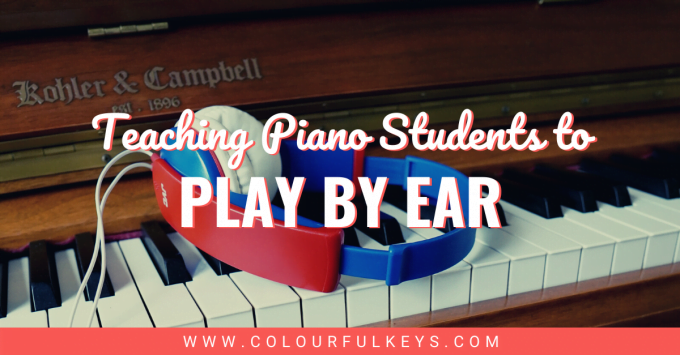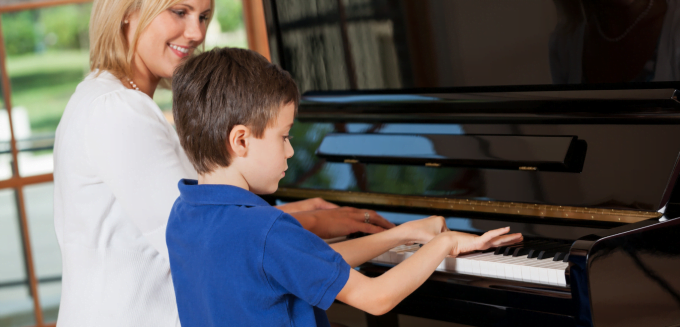Playing piano by ear is one of those skills which is often squashed in traditional lessons in favour of developing reading skills. But the two can absolutely coexist.

Some students just naturally gravitate towards playing piano by ear. They tend to get all the press, as teachers are often grappling to find ways to teach them to read music as well.
What about the other way around, though? Can we teach piano students to play by ear if they don’t do it instinctively?
I believe we not only can, but should teach all our students how to play piano by ear.
In this article, I’ll give you my step-by-step process to get your students started along with 2 examples of how the process will look in action.
For the generalist student who doesn’t have any strong opinions about what they want to learn, I recommend getting them started with playing folk songs by ear. For students with specific requests or strong inclinations towards a particular genre, you can work on this skill using any song they want to learn.
The basic process you’ll follow in either case is:
- Find the starting note and key.
- Use guiding questions to aid discovery.
- Double-check and practice.

Let’s take a closer look at how that might unfold when you’re teaching a folk song or a song your student has requested.
Teach Piano Students to Play Folk Songs by Ear
If your student doesn’t have any particular song requests, a folk song which they know well is a great place to start.
I often start with ‘Happy Birthday’, as every student knows it and it’s a nice juicy one to work out. If your student needs something a bit easier you might go with ‘Hot Cross Buns’ or ‘Mary Had a Little Lamb’ to get them going.
Whatever you choose, make sure they know it and can sing it for you! It’s going to be very hard and demotivating to try and play a song by ear if they aren’t that familiar with it.
Step 1: Starting Note and Key
Choose a key which will make things easy for your student and tell them what note to start on.
You can also tell them the key if they already have some scale knowledge, or just give a simple explanation such as telling them it only uses the white keys.
Step 2: Guiding Questions
Some students will immediately start guessing at random keys and listening to see if it sounds right. You just sit back and relax! 😉
Other students need a bit more guidance, or are nervous about getting it wrong. If you have a student like that, some questions can be helpful for them to think the song through.
- Does the next note sound higher or lower?
- Is it a big jump or a small jump?
- Was that note shorter or longer than the last one?
- Is this bit the same as a part we worked out already or is it brand new?

When they can’t answer a question, encourage them to sing the song to check. They can pause on the next note to really think about how it relates to the one before it.
Step 3: Check Your Work
The last step is to get them to play the song from start to finish, while singing, so that they can check if it sounds right.
They may need to work out certain bits that they’ve forgotten again, too. That’s all part of the process and will help them remember it better in the long-run.
If your student is doing well with this at the lesson, ask them to try and figure it out in a different key (or starting on a different note) at home for a fun challenge! They will know it so much more thoroughly once they’ve transposed it.
Teach Piano Students to Play Any Song by Ear
I ask my students regularly for song requests. I think it’s really important that they know I consider all music to be equal and am happy to help them with any genre.
As I talked about in my YouTube video about teaching pop music, though, my approach needs to change based on the type of music they bring in and what arrangements of it are available.
Sometimes, the best approach for one of these song requests is to work on their aural skills and play it by ear.
The process for this is almost the same as above. The main difference is that you, the teacher, may not know the song very well!
Step 1: Starting Note and Key
Instead of choosing a comfortable key, I recommend working it out in the original key so that they can play along with the track to test their work.
- Play the start of the song (or part of song they want to figure out) and pause.
- Search for the key on the piano.
- Play the start of the song again and play the note you think it is with the track to see if they match.
- Repeat until you find the starting note.
Yes, this can be tedious…it can also be surprisingly quick! Either way, the more you do this the better you and your student will get at this type of work. Stick with it.
Quick Tip: My favourite method of playing the song is through YouTube so that I can use the back arrow on my computer keyboard to go back 5 seconds when we need to hear the notes over and over.
Step 2: Guiding Questions
The main process of working out the melody by ear is the same for a pop song as it is for a folk song.
Just ask questions about the direction/patterns in the music, and keep playing and singing the song over and over. They will get there eventually. 🙂
Step 3: Check Your Work
This is the most satisfying part since we stuck with the original key.
Once your student has figured out a particular section of the song, make sure to play the recording or video while they play along on the piano. It may take them a few goes if it’s a quick one, but it’s super fun when they get it.
How do you teach your piano students to play by ear?
There are many approaches to take with these skills. I’d love to hear your thoughts in the comments or in the Vibrant Music Studio Teachers Facebook group. And for more tips on ear training in piano lessons, check out the ear training section of my Music Theory page.
I would like to purchase your course in color learning piano. But there is no Phone number address or other ways to order
Hi Basil,
Could you contact us here so we can understand better what you are looking for and proceed with that?